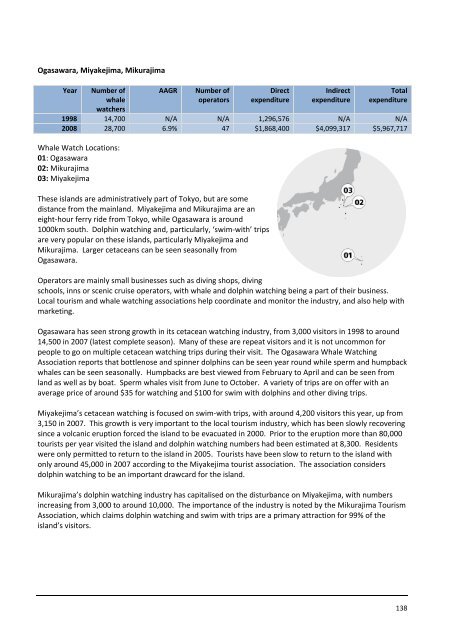Whale Watching Worldwide
Whale Watching Worldwide
Whale Watching Worldwide
Create successful ePaper yourself
Turn your PDF publications into a flip-book with our unique Google optimized e-Paper software.
Ogasawara, Miyakejima, Mikurajima<br />
Year Number of<br />
whale<br />
watchers<br />
AAGR Number of<br />
operators<br />
Direct<br />
expenditure<br />
Indirect<br />
expenditure<br />
Total<br />
expenditure<br />
1998 14,700 N/A N/A 1,296,576 N/A N/A<br />
2008 28,700 6.9% 47 $1,868,400 $4,099,317 $5,967,717<br />
<strong>Whale</strong> Watch Locations:<br />
01: Ogasawara<br />
02: Mikurajima<br />
03: Miyakejima<br />
These islands are administratively part of Tokyo, but are some<br />
distance from the mainland. Miyakejima and Mikurajima are an<br />
eight‐hour ferry ride from Tokyo, while Ogasawara is around<br />
1000km south. Dolphin watching and, particularly, ‘swim‐with’ trips<br />
are very popular on these islands, particularly Miyakejima and<br />
Mikurajima. Larger cetaceans can be seen seasonally from<br />
Ogasawara.<br />
Operators are mainly small businesses such as diving shops, diving<br />
schools, inns or scenic cruise operators, with whale and dolphin watching being a part of their business.<br />
Local tourism and whale watching associations help coordinate and monitor the industry, and also help with<br />
marketing.<br />
Ogasawara has seen strong growth in its cetacean watching industry, from 3,000 visitors in 1998 to around<br />
14,500 in 2007 (latest complete season). Many of these are repeat visitors and it is not uncommon for<br />
people to go on multiple cetacean watching trips during their visit. The Ogasawara <strong>Whale</strong> <strong>Watching</strong><br />
Association reports that bottlenose and spinner dolphins can be seen year round while sperm and humpback<br />
whales can be seen seasonally. Humpbacks are best viewed from February to April and can be seen from<br />
land as well as by boat. Sperm whales visit from June to October. A variety of trips are on offer with an<br />
average price of around $35 for watching and $100 for swim with dolphins and other diving trips.<br />
Miyakejima’s cetacean watching is focused on swim‐with trips, with around 4,200 visitors this year, up from<br />
3,150 in 2007. This growth is very important to the local tourism industry, which has been slowly recovering<br />
since a volcanic eruption forced the island to be evacuated in 2000. Prior to the eruption more than 80,000<br />
tourists per year visited the island and dolphin watching numbers had been estimated at 8,300. Residents<br />
were only permitted to return to the island in 2005. Tourists have been slow to return to the island with<br />
only around 45,000 in 2007 according to the Miyakejima tourist association. The association considers<br />
dolphin watching to be an important drawcard for the island.<br />
Mikurajima’s dolphin watching industry has capitalised on the disturbance on Miyakejima, with numbers<br />
increasing from 3,000 to around 10,000. The importance of the industry is noted by the Mikurajima Tourism<br />
Association, which claims dolphin watching and swim with trips are a primary attraction for 99% of the<br />
island’s visitors.<br />
138

















